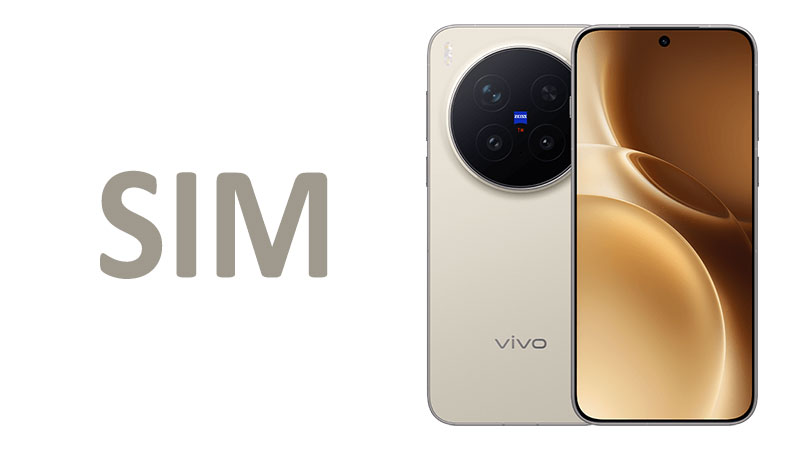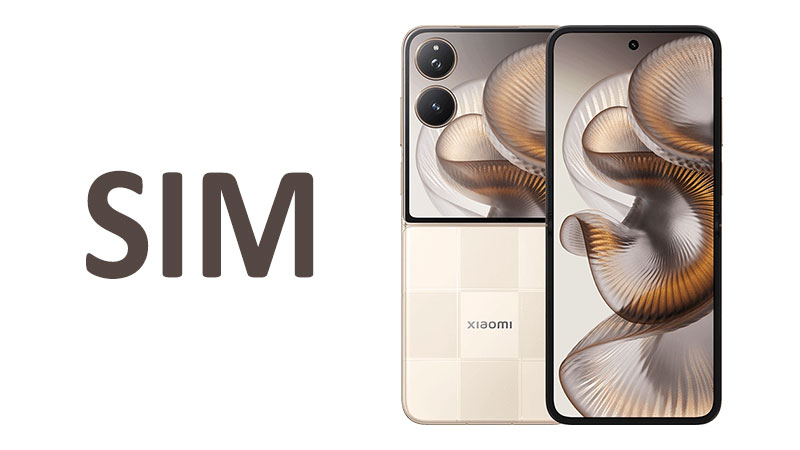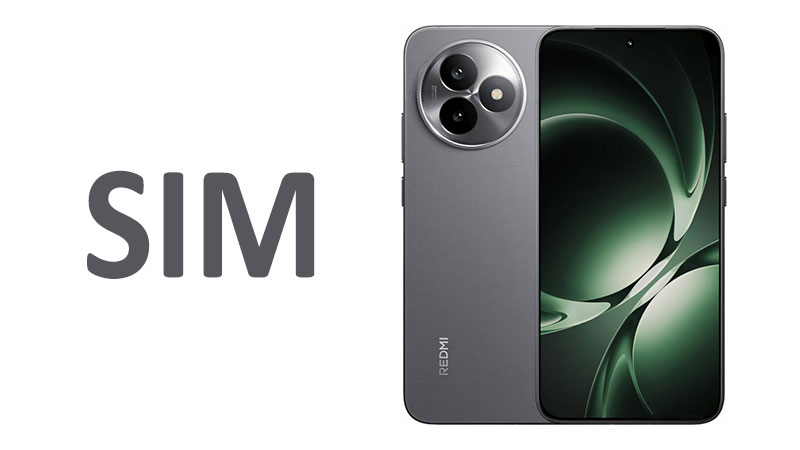The vivo X300 Pro SIM and connectivity suite defines its user experience. This phone is a flagship device. It promises cutting-edge performance in global communication. A deep dive into its specifications reveals significant advancements. These improvements cover everything from SIM flexibility to network speed. This comprehensive review examines all aspects of the vivo X300 Pro’s connectivity. It will help buyers understand this smartphone’s true potential. We will look closely at its SIM setup and wireless capabilities. This review also provides necessary comparisons and practical insights.
Understanding the vivo X300 Pro SIM Flexibility
The SIM configuration is often overlooked. However, it is a crucial component of modern smartphone usage. The vivo X300 Pro offers different configurations. These designs cater specifically to international and Chinese markets. This differentiation highlights the device’s market strategy.
International SIM Configuration: eSIM and Dual-SIM Power
The international model offers maximum flexibility. It supports a combination of physical Nano-SIMs and an integrated eSIM. Specifically, the configuration is Nano-SIM plus Nano-SIM plus eSIM. Importantly, the phone can only utilize two active lines at any one time. This is a powerful feature for global travelers. It also helps professionals who manage separate work and personal numbers.
The inclusion of an eSIM is a major technological leap. An eSIM, or embedded SIM, is a digital SIM card. It allows users to activate a cellular plan remotely. There is no need for a physical SIM card. This drastically simplifies the process of changing carriers. It is also much easier to add a local plan when traveling abroad.
Using an eSIM enhances security. Furthermore, it frees up physical space inside the device. This small change contributes to the phone’s slim design. Consequently, users gain seamless connectivity options. They can use one physical SIM for their home number. They can also use the eSIM for a secondary line or international roaming. This is a very convenient setup.
China Market SIM Configuration: Dual Nano-SIM
The Chinese market model simplifies the setup. It relies exclusively on two physical Nano-SIM slots. The configuration is Nano-SIM plus Nano-SIM. This version does not include eSIM functionality. This choice reflects regional preferences and carrier infrastructure.
This pure dual-SIM setup still allows for two active lines simultaneously. Chinese users can easily manage two local networks or numbers. This maintains the essential dual-line utility. However, it sacrifices the digital convenience provided by the eSIM. Prospective international buyers must confirm the model they purchase. The presence of the eSIM is a key differentiating factor.
Specialized Comparison: eSIM vs. Traditional Dual-SIM
Previous vivo flagship models often featured a hybrid SIM tray. This tray usually allowed either two Nano-SIMs or one SIM and a microSD card. The X300 Pro eliminates this hybrid compromise. It fully separates the connectivity needs from storage needs.
The main difference is the versatility provided by eSIM. Older dual-SIM phones require buying a physical card for every network change. The vivo X300 Pro simplifies this. It allows instant activation of new plans with the eSIM. This feature is superior for frequent travelers. It minimizes the hassle of managing small physical cards. Therefore, the X300 Pro’s approach is far more modern and user-friendly.
SIM Pros and Cons
| Aspect | Pros | Cons |
|---|---|---|
| International Model | Superior flexibility with eSIM support. | Only two lines can be active concurrently. |
| International Model | Easier global travel and carrier switching. | Requires carrier support for eSIM activation. |
| China Model | Reliable physical dual-SIM operation. | Lacks the digital convenience of eSIM. |
| Both Models | Dedicated dual connectivity (max 2 active). |
The Network Backbone: 5G and Global Compatibility
The vivo X300 Pro connectivity foundation is robust. It supports all major mobile network technologies. These technologies are GSM, HSPA, LTE, and 5G. This ensures compatibility worldwide. Users will enjoy reliable service regardless of their location.
The Power of 5G Integration
Fifth-generation (5G) connectivity is the star feature. It provides significantly faster data speeds than LTE. Furthermore, it offers extremely low latency. This is crucial for applications like cloud gaming and real-time video conferencing. The X300 Pro uses advanced modem technology. This ensures optimal performance across available 5G bands.
This comprehensive 5G support is essential for future-proofing the device. As 5G networks continue to expand globally, the phone is ready. Users will benefit from improved download and upload speeds. This enhanced speed transforms the mobile internet experience. Streaming high-resolution content becomes effortless and instantaneous.
The phone supports all previous generations as well. It smoothly transitions between 5G, LTE (4G), HSPA (3G), and GSM (2G). This backward compatibility guarantees service even in remote areas. This comprehensive support is vital for uninterrupted communication.
Important Points for Buyers
Buyers should verify 5G band support in their region. The X300 Pro must support the specific bands used by their local carrier. Most flagship phones offer wide band coverage. However, checking this detail is always recommended for maximum speed. Furthermore, the 5G network must be available in the area of use. Otherwise, the phone will operate on the faster LTE network.
Next-Generation Wireless Speed: Wi-Fi 7
The wireless local area network (WLAN) specification is highly advanced. The vivo X300 Pro boasts support for Wi-Fi 802.11 a/b/g/n/ac/6/7. The inclusion of Wi-Fi 7 is a substantial upgrade. It represents the pinnacle of current wireless technology.
Deep Dive into Wi-Fi 7 (802.11be)
Wi-Fi 7, also known as IEEE 802.11be, is the new standard. It offers revolutionary improvements over Wi-Fi 6 and 6E. This technology provides much higher throughput and lower latency. It is designed to handle demanding applications. These include 8K video streaming and high-fidelity augmented reality.
A key feature of Wi-Fi 7 is Multi-Link Operation (MLO). MLO allows the device to simultaneously transmit and receive data. This occurs across different frequency bands and channels. It essentially aggregates capacity for faster speeds. MLO also enhances reliability by providing backup links.
Another major improvement is 4K Quadrature Amplitude Modulation (4K QAM). This allows the device to pack more data into each transmission. It increases peak data rates significantly. Consequently, the X300 Pro can achieve blazing-fast wireless speeds. The phone will perform optimally in crowded network environments.
Dual-Band and Backward Compatibility
The phone supports dual-band operation. This means it can connect to both 2.4 GHz and 5 GHz networks. It can also utilize the 6 GHz band under Wi-Fi 6E/7. The 2.4 GHz band offers a wider range. However, it is often slower. The 5 GHz and 6 GHz bands provide faster speeds. They are, however, limited to shorter distances. The X300 Pro intelligently manages these bands. It ensures the best connection quality at all times.
The comprehensive backward compatibility is also important. It ensures the X300 Pro connects seamlessly to older routers. It works perfectly with Wi-Fi 5 (802.11ac) and even older standards. This makes the phone usable in any setting.
Specialized Comparison: X300 Pro Wi-Fi 7 vs. Competitors
Most current flagships use Wi-Fi 6 or 6E. Wi-Fi 6E introduced the 6 GHz band for faster, less congested access. However, Wi-Fi 7 goes much further than 6E. It introduces the critical MLO and 4K QAM features.
The vivo X300 Pro takes a significant lead in this area. It offers a clear future-proof advantage. Devices with Wi-Fi 7 will handle network load much better. They will provide a more stable connection in high-density areas. This is a crucial selling point for power users.
Wi-Fi Pros and Cons
| Aspect | Pros | Cons |
|---|---|---|
| Wi-Fi 7 (802.11be) | Extremely high speed and lower latency. | Requires a Wi-Fi 7 router to maximize benefits. |
| Multi-Link Operation | Enhanced reliability and aggregated bandwidth. | Current Wi-Fi 7 infrastructure is still sparse. |
| Comprehensive Band Support | Full backward compatibility with older networks. |
Bluetooth and High-Fidelity Audio Excellence
The Bluetooth specification on the vivo X300 Pro is equally impressive. It features Bluetooth 5.4. This is the latest iteration of the standard. This version brings key improvements in efficiency and security.
Bluetooth 5.4: Efficiency and Security
Bluetooth 5.4 offers superior security features. It also provides better power management compared to earlier versions. This results in longer battery life for connected accessories. These accessories include wireless earbuds and smartwatches. Furthermore, it improves the stability of the wireless connection. The communication between the phone and accessories is more reliable.
The phone supports several key profiles and codecs. These are A2DP and LE (Low Energy). A2DP enables high-quality stereo audio streaming. LE is essential for connecting to power-efficient devices.
High-Resolution Audio Codecs: aptX HD and LHDC 5
For audiophiles, the supported audio codecs are crucial. The X300 Pro supports both aptX HD and LHDC 5. These codecs are designed for high-resolution wireless audio transmission.
aptX HD delivers 24-bit audio quality over Bluetooth. This results in richer and more detailed sound. LHDC 5 (Low-Latency High-Definition Audio Codec) takes this further. LHDC 5 is capable of streaming true Hi-Res audio. It supports extremely high bitrates. This offers a listening experience very close to wired connections.
The inclusion of LHDC 5 demonstrates a strong focus on audio quality. This is a massive benefit for users who prioritize wireless sound fidelity. Most competitors only offer standard Bluetooth codecs. The X300 Pro offers a superior wireless audio experience.
Connectivity Features: NFC and Infrared
The vivo X300 Pro includes two practical auxiliary features. These are Near Field Communication (NFC) and an Infrared (IR) port.
NFC functionality enables contactless payments. It also allows for quick data sharing with other NFC-enabled devices. Users can easily use services like Google Pay. They can tap to pay at checkout counters.
The Infrared port is a convenient addition. It allows the phone to function as a universal remote control. Users can control home appliances. These appliances include televisions, air conditioners, and sound systems. This is a small but useful feature that many competitors have removed.
Important Note: Radio Absence
The phone does not include a built-in FM radio. This is common among modern flagship smartphones. Most users stream radio via internet apps. The absence of an FM radio is unlikely to affect most users. However, it is a point of note for those who rely on traditional radio broadcast.
Precision Location and Global Navigation Systems
Navigation and location accuracy are critical for mapping and services. The vivo X300 Pro excels with its comprehensive positioning system. It supports an unprecedented number of global navigation satellite systems (GNSS).
Dual-Frequency GPS and Enhanced Accuracy
The X300 Pro utilizes dual-frequency GPS. It receives signals on both the L1 and L5 frequencies. The traditional L1 signal is used by most devices. The L5 frequency provides higher accuracy and better resilience. It helps reduce common sources of error.
Dual-frequency support leads to much better positional accuracy. This is especially true in challenging environments. These areas include urban canyons with tall buildings. It provides a significant advantage for precise location services.
Comprehensive Global System Support
The phone supports a wide array of global and regional systems:
- GPS (L1+L5): The United States’ global system.
- GLONASS (L1): Russia’s global system.
- BDS (B1I+B1c+B2a+B2b): China’s BeiDou Navigation Satellite System. The X300 Pro uses multiple BDS frequencies. This ensures high redundancy and accuracy.
- GALILEO (E1+E5a+E5b): Europe’s global system. The device uses multiple GALILEO frequencies.
- QZSS (L1+L5): Japan’s Quasi-Zenith Satellite System. This enhances GPS accuracy in the Asia-Oceania region.
- NavIC (L5): India’s regional system. NavIC support is crucial for enhanced accuracy in the Indian subcontinent.
Comparison: Flagship Navigation
Many flagship phones offer dual-frequency GPS. However, the X300 Pro’s support is exceptionally broad. The multi-frequency support for BDS and GALILEO is superior. The inclusion of NavIC demonstrates a commitment to regional performance. This robust system translates to faster lock times and reliable navigation. This level of detail is important for professional users. It also helps anyone who relies on precise location data.
Positioning Pros and Cons
| Aspect | Pros | Cons |
|---|---|---|
| Dual-Frequency GPS (L1+L5) | Highly accurate and reliable location locking. | Requires more complex antenna design and processing. |
| Global GNSS Coverage | Unmatched redundancy and worldwide coverage. | |
| NavIC Support (L5) | Superior performance in the Indian subcontinent. |
Wired Connectivity: USB Type-C 3.2 and OTG
Wired connectivity is often as important as wireless speed. The vivo X300 Pro features a modern USB standard. It uses USB Type-C 3.2. This ensures rapid data transfer and charging.
USB Type-C 3.2 Speed
USB 3.2 offers significantly faster data transfer rates. These speeds are much quicker than the older USB 2.0 standard. Users can transfer large files, such as 4K video, very quickly. This is a huge time-saver for content creators and professionals. The fast transfer speed complements the phone’s high-speed cameras.
The Type-C port is also reversible. This makes plugging in the cable simple and effortless. It is the standard connector for modern devices.
OTG Functionality
The phone supports On-The-Go (OTG) functionality. OTG allows the phone to act as a host device. Users can connect various peripherals directly to the phone. These peripherals include flash drives, external keyboards, and mice. OTG enhances the phone’s utility. It effectively transforms it into a portable computing hub.
Specialized Comparison: USB 3.2 vs. USB 2.0
Some competing flagship models still use the slower USB 2.0 standard. This can limit data transfer speeds to around 480 Mbps. USB 3.2, in contrast, offers speeds up to 20 Gbps (for Gen 2×2, though specific speeds vary). Even if the X300 Pro utilizes Gen 2 (10 Gbps), it is a massive improvement. This faster wired connection is a necessity for a high-end device. It greatly improves the user’s workflow efficiency.
Wired Connectivity Pros and Cons
| Aspect | Pros | Cons |
|---|---|---|
| USB Type-C 3.2 | Extremely fast data transfer speeds. | Requires a compatible cable to achieve max speed. |
| OTG Support | Expands phone utility with external peripherals. |
Buyer’s Critical Takeaways and Summary
The vivo X300 Pro is designed for the future of mobile connectivity. Its specifications are not just adequate. They are clearly ahead of the curve in several key areas. This level of detail sets the phone apart.
The key advantage is the blend of flexibility and speed. The SIM tray flexibility with eSIM is perfect for a global lifestyle. The Wi-Fi 7 inclusion is a powerful, future-proof feature. It guarantees top-tier wireless internet performance. This performance will last for years to come.
Buyers must consider a few points. To utilize Wi-Fi 7, they must upgrade their home router. Otherwise, the phone will default to the best available standard, like Wi-Fi 6. Furthermore, users should confirm the eSIM support with their local carrier. Not all carriers currently offer this service.
The comprehensive GNSS support is excellent for travelers. It also helps those who depend on highly accurate mapping apps. The inclusion of the Infrared port is a niche but appreciated feature. Overall, the connectivity package is robust, fast, and highly reliable. It confirms the phone’s status as a premium device.
The phone’s focus on high-fidelity audio is also a strong point. The support for LHDC 5 ensures a premium listening experience. This makes the X300 Pro ideal for media consumption. The entire connectivity system showcases exceptional technical depth.
Conclusion
The vivo X300 Pro SIM, Dual-SIM, and eSIM capabilities are outstanding. They represent a leading solution in the smartphone market. The phone’s network technology is equally advanced. The inclusion of Wi-Fi 7 and Bluetooth 5.4 ensures future-proof speed. Furthermore, the extensive GNSS array provides unmatched location accuracy.
The hardware choices reflect a commitment to performance and global usability. While the Chinese model lacks the eSIM, the international version is remarkably versatile. For consumers prioritizing cutting-edge speed, audio quality, and connection reliability, this phone is a superior choice. The robust connectivity suite provides peace of mind. It ensures excellent performance today and readiness for tomorrow’s networks.
Frequently Asked Questions (FAQ)
Is the vivo X300 Pro a true Dual-SIM phone internationally? Yes, the international version supports a maximum of two active lines. This can be two physical Nano-SIMs or one Nano-SIM and one eSIM.
Does the phone support the new Wi-Fi 7 standard? Yes, the phone supports Wi-Fi 802.11be, which is commonly known as Wi-Fi 7. This is a key feature.
What is the benefit of the USB Type-C 3.2 port? USB Type-C 3.2 allows for much faster data transfer. This is essential for quickly moving large video or photo files to a computer.
Can I use the vivo X300 Pro as a TV remote control? Yes, the phone includes an Infrared (IR) port. This allows it to function as a universal remote control for various appliances.
How does the connectivity compare to older vivo models? It is a major upgrade. Older models typically lacked Wi-Fi 7, Bluetooth 5.4, multi-frequency GNSS support, and the LHDC 5 audio codec.



